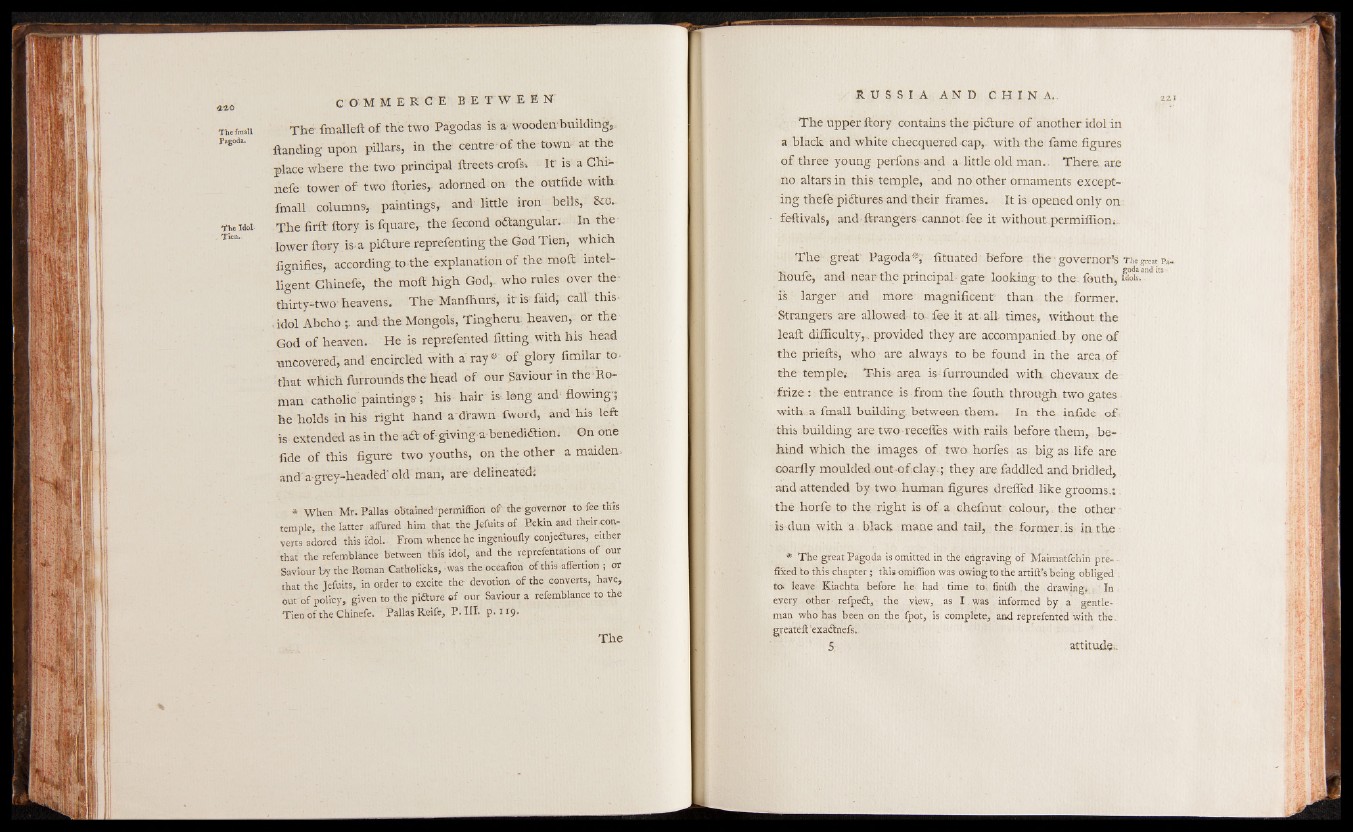
The fmaii The fmalleft of the two Pagodas is a wooden building» ,
P‘EOda' ftanding upon pillars, in the centre-of the town- at the
place where the two principal ftreets crofs-. It’ is a Chinefe
tower of two ftories,- adorned on the otitfide with
fmall columns, paintings» and little iron bells, 8ro.
The idol The firft ftory is fquare, the fecond oft angular. In the
lower ftory . is, a picture reprefenting the God Tien, which
fignifies, according to the explanation of the moft intelligent
Chinefe, the moft high God,- who rules over the-
thirty-two heavens. The Manfhurs, it is faid, call this-
idol Abcho and: the Mongols, Tingheru heaven, or the
God of heaven. He is reprefented fitting with his head
uncovered, and encircled with a' ray* of glory fimilar to-
that which furrounds the head o f our Saviour in the “Roman
catholic paintings; his hair is long and- flowing,
he holds in his right hand a'drawn fword, and his left
is extended as in the aft of giving a-benedi&ion. Gn one
fide of this figure two youths, on the other a maiden,
and a grey-headed' old man, are delineated!
* When: Mr. Pallas obtained-permiffion o f the governor to lee this
temple, , the latter affined him that the Jefuits o f Pekin and their converts
adored this idol. From whence he ingenioufly conjedtures, either
that the refemblance between this idol, and the reprefentationsof our
Saviour by the Roman Catholicks, :was the oceafion of this ■ affertion ; or
that the Jefuits, in order to excite the- devotion o f the converts, have,
out o f policy, given to.tKe pifture o f our Saviour a refemblance to the
Tien o f the Chinefe, Pallas Reife, P. III. p .1 1 9 .
The
The upper ftory contains the picture of another idol in
a black and white checquered cap, with the fame figures
of three young perfons and a-little old man.. There are
no altars in this temple, and no other ornaments excepting
thefe pictures and their frames. It is opened only on
feftivals, and-ftrangers cannot fee it without.permifliom.
The great' Pagoda*,' fituated before the governor’ S The great Pa* r , , . . , . . . godaandits
noule, and near the principal gate looking to the fouth, ld°ls-
is larger and more magnificent- than the former.
Strangers are allowed to fee it at-all- times, without the
leaft difficulty,... provided they are accompanied-by one of
the priefts, who are always to be found in the area of
the temple.- This area is furrounded with chevaux de
fr ize: the entrance is from the fouth through two gates
with a fmall building between them. In the infide of,
this building are two recefiès with rails before them, behind
which the images of two horfes as big as life are
coarfly moulded outofclay; they are faddled and bridled,
and attended by two human figures drefled like grooms.:.
thé horfe to the right is of a chefnut colour, the other -
is dun with a black mane and tail, the former, is in the
1 The great Pagoda is omitted in the engraving o f Maimntfchin pre* -
fiked to this chapter; this omiffion was owing to the artift-’s being obliged :
to. leave Kiachta before he, had time to. finilh the drawing, j In
eyery other , refpeft, the view, as I . was . informed by a gentleman
who has been on the fpot, is complete, and reprefented with the.,
greateft ‘exadtnefs.,
5 attitude,.